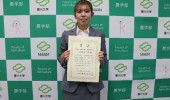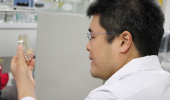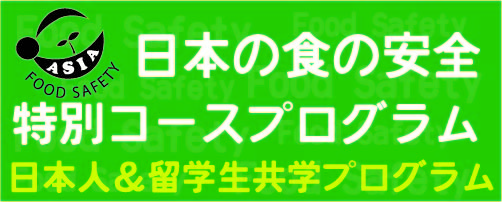領 域 名 食品科学
教員氏名 川 村 理
研究分野 食品衛生学

研究キーワード:マイコトキシン(カビ毒)、マイクロシスチン(アオコ毒)、モノクローナル抗体、イムノアフィニテーカラム、ELISA、食の安全

最近の研究課題
マイコトキシン(カビ毒)は、カビが生産する有毒2次代謝産物で、人や家畜に病理的障害を与えることが知られている。カビは、圃場などで作物に感染し、収穫前の圃場や収穫後の保管中に生育し、農作物を汚染する。マイコトキシンは低分子化合物であり、カビが死滅後も残留し、かつ熱に安定で調理程度の加熱ではほとんど分解しない。さらに、動物用飼料を介して畜産物へ移行することも知られている。マイコトキシンは、微量ながら多様な食品を汚染しており、こららを長期間摂取することで、「がん」などの慢性中毒を引き起こしていると考えられている(図1)。

1.マイコトキシンに対するモノクローナル抗体の作製、分析法の確立と食品汚染調査
微量ながら多様な食品を汚染しているマイコトキシンの汚染レベルを明確にするためには、簡便かつ高感度な分析法が必要であり、現在は、抗体を用いた免疫化学的分析法が汎用されている。そのために必要なマイコトキシンに対するモノクローナル抗体を作製している(図2)。
作製した抗体を結合させたイムノアフィニテーカラムを作製し、食品抽出液のクリーンナップを行いHPLCで定量する方法を確立し、国内や海外での市販食品中のマイコトキシン汚染調査や食品加工中のマイコトキシンの挙動実験などを行っており、いくつかの新知見を得ている。

2.マイクロシスチン(アオコ毒)に対するモノクローナル抗体の作製と環境水汚染調査
マイクロシスチン(MC)は富栄養化した湖沼で発生するアオコが作る毒素の1つで、最も毒性の強いのがMC-LRである。海外ではMC汚染水の摂取で家畜やヒトの健康被害が発生している。香川県には1,400以上の溜池があり、夏季には多くの溜め池でアオコが発生している(図3)。しかし、MCの汚染調査はほとんど行われていない。そこで、香川の溜池のMC汚染レベルを明らかにすることを目的に、MC-LRに対するモノクローナル抗体を作製し、WHOの飲料水の基準 1 µg/Lの1/10以下の80 ng/LまでのMC-LRを測定できるELISA法を確立した。現在、本法を用いて香川の溜め池の汚染調査を実施しており、一部の溜池のMC高濃度汚染を明らかにした。


代表的な研究業績
- A. T. Ishikawa, O. Kawamura et. al., , Exposure Assessment of Infants to Aflatoxin M1 through Consumption of Breast Milk and Infant Powdered Milk in Brazil. Toxins, 8, 246-256 (2016)
- 田渕結実、川村 理:香川大学農学部近郊の溜池,男井間池と平田池のマイクロシスチン汚染調査(2014)、香川大学農学部学術報告 69,23-26 (2017).
- 光元結花、川村 理:讃岐うどん調理中のオクラトキシンAの挙動と市販讃岐うどん・そうめん中のオクラトキシンAの汚染調査、香川大学農学部学術報告 69,27-30 (2017).
Research Area: Food Science
Research Specialization: Food Hygiene
Name: KAWAMURA, Osamu

Keywords:Mycotoxin, Microcystine (algae toxin), Monoclonal antibody, Immunoaffinity column, ELISA, Food safety

Recent Research
Mycotoxins, the toxic second metabolites of some fungi, give healthy damage to humans and domestic animals. These fungi are infected with the crops in farms, and the fungi grow on per-/post-harvest crops and produce mycotoxins. Mycotoxins remain on the crops after extinction of the fungi, and are heat stable compounds, therefore after cooking, remain in foods. Furthermore, it is known that mycotoxins in animal feeds are transferred to livestock products. A variety of food is contaminated with small quantity of mycotoxins. By an intake of these food for a long term, it is thought that mycotoxins cause the chronic poisoning such as “cancers”.

1. Production of monoclonal antibodies against mycotoxins, Development of the immunochemical analysis for mycotoxins in foods, Food contamination investigation, and Risk evaluation
To make clear contamination level of mycotoxins in foods, a simple and easy and high sensitive analysis methods are necessary. Now, the immunochemical methods using antibody are frequently used. We made monoclonal antibodies (mAb) against major mycotoxins, and established immunoaffinity column-HPLC methods using these mAb.
We analyzed mycotoxins in commercial foods, such as rice, coffee, cocoa, and ramen from Japan and Asian countries and feeds for chicken from Brazil and Indonesia We performed behavior experiments of mycotoxin during food processing. We obtained some new findings.

2. Occurrence of algae toxin (microcystine) in fresh water
Microcystin-Leu-Arg (MC-LR) is one of toxic cyanotoxins, which are contaminated with eutrophicated lakes and ponds. We established a sensitive ELISA method for detection of MC-LR in environmental water using our novel mAb. Our best MC.5-3 mAb was a little strongly reacted to MC-RR than MC-LR, and almost same to MC-YR. The sensitivity of our ELISA was 80 pg/mL of MC-LR. This value was less than 1/10 of the regulation level (1 ng/mL) in drinking water by WHO. Using this ELISA, we perform the pollution investigation into reservoirs of Kagawa.


Publications
- A. T. Ishikawa, O. Kawamura et.al.; Exposure Assessment of Infants to Aflatoxin M1 through Consumption of Breast Milk and Infant Powdered Milk in Brazil. Toxins, 8, 246-256 (2016)
- Y. Tbuchi & O. Kawamura; Occurrence of microcystins in Oima Pond and Hirata Pond which were reservoirs in the suburbs of Faculty of Agriculture, Kagawa University. (2014)、Technical Bulletin of Faculty of Agriculture, Kagawa University, 69,23-26 (2017).
- Y. Mistumoto & O. Kawamura; Decrease of ochratoxin A during cooking of Sanuki udon and occurrence of ochratoxin A in commercial Sanuki udon and somen, Technical Bulletin of Faculty of Agriculture, Kagawa University, 69,27-30 (2017).
このページの管理者:管理者















